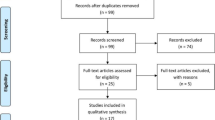Abstract
Purpose
Postoperative pain in arthroscopic shoulder surgery cannot be easily controlled with analgesics and nerve blocks. This study shows the analgesic effect of interscalene block (ISB) and suprascapular nerve block and axillary nerve block (SSNB + ANB) in patients under patient controlled analgesia (PCA).
Methods
Sixty-one patients (26 men and 35 women) who underwent arthroscopic rotator cuff repair were selected and allocated non-randomly to one of three groups: PCA only-group, PCA with ISB-group and PCA with SSNB + ANB-group. Visual analogue scale (VAS) score, degree of satisfaction, PCA usage and incidence of nausea and vomiting were evaluated at the recovery room, 8, 16 and 24 postoperative hours.
Results
The VAS score of the PCA only-group was highest at the recovery room. The VAS score of the PCA with ISB-group was the lowest, however, with large fluctuations over time. Although the VAS score of the PCA with SSNB + ANB-group was higher than that of the PCA with ISB-group, it was steadily lower than the PCA-only group, without any fluctuations. The degree of satisfaction of the PCA with ISB-group was highest at the recovery room. The number of times the PCA was used at the 8-h postoperative evaluation was largest in the PCA only-group.
Conclusions
The initial 24 h after surgery plays a key role in controlling pain after arthroscopic shoulder surgery. PCA with SSNB + ANB is a better anaesthetic choice than PCA with ISB or PCA only during the initial 24 h of the postoperative period.
Level of evidence
Clinical study, Level II.
Similar content being viewed by others
References
Barber FA (2005) Suprascapular nerve block for shoulder arthroscopy. Arthroscopy 21(8):1015.e1–e4
Borgeat A, Ekatodramis G (2002) Anaesthesia for shoulder surgery. Best Pract Res Clin Anaesthesiol 16:211–225
Boss AP, Maurer T, Seiler S, Aeschbach A, Hintermann B, Strebel S (2004) Continuous subacromial bupivacaine infusion for postoperative analgesia after open acromioplasty and rotator cuff repair: preliminary results. J Shoulder Elbow Surg 13:630–634
Brown AR, Weiss R, Greenberg C, Flatow EL, Bigliani LU (1993) Interscalene block for shoulder arthroscopy: comparison with general anesthesia. Arthroscopy 9(3):295–300
Checcucci G, Allegra A, Bigazzi P, Gianesello L, Ceruso M, Gritti G (2008) A new technique for regional anesthesia for arthroscopic shoulder surgery based on a suprascapular nerve block and an axillary nerve block: an evaluation of the first results. Arthroscopy 24(6):689–696
D’Alessio JG, Rosenblum M, Shea KP, Freitas DG (1995) A retrospective comparison of interscalene block and general anesthesia for ambulatory surgery shoulder arthroscopy. Reg Anesth 20(1):62–68
Dekrey JA, Balas GI (1981) Regional anesthesia for surgery on the shoulder. A review of 1500 cases. Anaesthesist 30(7):46–48
DeMarco JR, Componovo R, Barfield WR, Liles L, Nietert P (2011) Efficacy of augmenting a subacromial continuous-infusion pump with a preoperative interscalene block in outpatient arthroscopic shoulder surgery: a prospective, randomized, blinded, and placebo-controlled study. Arthroscopy 27(5):603–610
Feigl GC, Anderhuber F, Dorn C, Pipam W, Rosmarin W, Likar R (2007) Modified lateral block of the suprascapular nerve: a safe approach and how much to inject? A morphological study. Reg Anesth Pain Med 32(6):488–494
Filos KS, Lehmann KA (1999) Current concepts and practice in postoperative pain management: need for a change? Eur Surg Res 31(2):97–107
Jerosch J, Saad M, Greig M, Filler T (2008) Suprascapular nerve block as a method of preemptive pain control in shoulder surgery. Knee Surg Sports Traumatol Arthrosc 16:602–607
Karatas GK, Meray J (2002) Suprascapular nerve block for pain relief in adhesive capsulitis: comparison of 2 different techniques. Arch Phys Med Rehabil 83:593–597
Kempen PM, O’Donnell J, Lawler R, Mantha V (2000) Acute respiratory insufficiency during interscalene plexus block. Anesth Analg 90(6):1415–1416
Lenters TR, Davies J, Matsen FA 3rd (2007) The types and severity of complications associated with interscalene brachial plexus block anesthesia: local and national evidence. J Shoulder Elbow Surg 16(4):379–387
Matsumoto D, Suenaga N, Oizumi N, Hisada Y, Minami A (2009) A new nerve block procedure for the suprascapular nerve based on a cadaveric study. J Shoulder Elbow Surg 18:607–611
Moote CA (1994) The prevention of postoperative pain. Can J Anaesth 41:527–533
Neal JM, McDonald SB, Larkin KL, Polissar NL (2003) Suprascapular nerve block prolongs analgesia after nonarthroscopic shoulder surgery but does not improve outcome. Anesth Analg 96:982–986
Pere P, Pitkänen M, Rosenberg PH, Björkenheim JM, Linden H, Salorinne Y, Tuominen M (1992) Effect of continuous interscalene brachial plexus block on diaphragm motion and on ventilatory function. Acta Anaesthesiol Scand 36(1):53–57
Price DJ (2007) The shoulder block: a new alternative to interscalene brachial plexus blockade for the control of postoperative shoulder pain. Anaesth Intensive Care 35:575–581
Schneider-Kolsky ME, Pike J, Connell DA (2004) CT-guided suprascapular nerve blocks: a pilot study. Skeletal Radiol 33:277–282
Shah RV, Racz GB (2003) Pulsed mode radiofrequency lesioning of the suprascapular nerve for the treatment of chronic shoulder pain. Pain Physician 6:503–506
Singelyn FJ, Lhotel L, Fabre B (2004) Pain relief after arthroscopic shoulder surgery: a comparison of intraarticular analgesia, suprascapular nerve block, and interscalene brachial plexus block. Anesth Analg 99:589–592
Urmey WF, McDonald M (1992) Hemidiaphragmatic paresis during interscalene brachial plexus block: effects on pulmonary function and chest wall mechanics. Anesth Analg 74:352–357
Uz A, Apaydin N, Bozkurt M, Elhan A (2007) The anatomic branch pattern of the axillary nerve. J Shoulder Elbow Surg 16:240–244
Vorster W, Lange CP, Briet RJ, Labuschagne BC, du Toit DF, Muller CJ, de Beer JF (2008) The sensory branch distribution of the suprascapular nerve: an anatomic study. J Shoulder Elbow Surg 17:500–502
Author information
Authors and Affiliations
Corresponding author
Rights and permissions
About this article
Cite this article
Lee, S.M., Park, SE., Nam, YS. et al. Analgesic effectiveness of nerve block in shoulder arthroscopy: comparison between interscalene, suprascapular and axillary nerve blocks. Knee Surg Sports Traumatol Arthrosc 20, 2573–2578 (2012). https://doi.org/10.1007/s00167-012-1950-5
Received:
Accepted:
Published:
Issue Date:
DOI: https://doi.org/10.1007/s00167-012-1950-5




